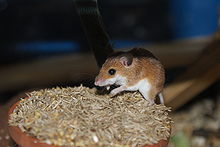- African Pygmy Mouse
-
African Pygmy Mouse 
African Pygmy Mouse eating Conservation status Scientific classification Kingdom: Animalia Phylum: Chordata Class: Mammalia Order: Rodentia Superfamily: Muroidea Family: Muridae Genus: Mus Species: M. minutoides Binomial name Mus minutoides
(A Smith, 1834)The African Pygmy Mouse, (Mus minutoides) is possibly the smallest of all rodents and one of the smallest mammals. It is widespread within sub-Saharan Africa, and is kept as a pet in other parts of the world. Like the common House Mouse, it is a member of the enormous superfamily Muroidea, which includes about 1000 different species.
Grey to brick-red overall, it is pale on the underside and has small but prominent triangular ears. Adults are between 30 and 80 mm (1.2 and 3.1 in) long, with a 20 to 40 mm (0.79 to 1.6 in) tail, and weigh from 3 to 12 g (0.11 to 0.42 oz).
African Pygmy Mice reach breeding age at about 6 to 8 weeks. Pregnancy lasts for around 20 days and the litter of about 3 young is born blind and hairless. Their eyes open after 2 weeks, and weaning is complete after 4 weeks. The lifespan is about 2 years, although individual specimens have been reported to live over 4 years in captivity.
The African Pygmy Mouse has a number of unique traits. It stacks pebbles in front of its burrow. Overnight the pebbles gather dew and in the morning the pygmy mouse drinks the dew on the pebbles. After that it retires back to its den. Its method of sex determination has also been found to differ from most mammals[1] in that rearrangements of the X chromosome have led to many XY individuals actually being female.
They live in colonies or in pairs in grass close to water. They prefer social interaction, and when kept as a pet they can not be left alone.[2]
References
- Monadjem (2004). Mus minutoides. 2006. IUCN Red List of Threatened Species. IUCN 2006. www.iucnredlist.org. Retrieved on 11 May 2006. Database entry includes a brief justification of why this species is of least concern
- ^ Frederic Veyrunes, Pascale Chevret, et al. (2010). "A novel sex determination system in a close relative of the house mouse". Proceedings of the Royal Society B Biological Sciences 277 (1684): 1049–1056. doi:10.1098/rspb.2009.1925.
- ^ http://heritage-pets.tripod.com/id53.html

